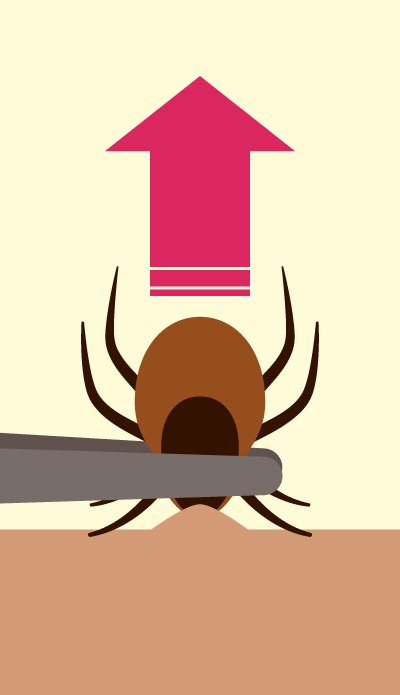Lyme and other tick-borne diseases
Public Health Ontario maintains the Ontario Vector-Borne Diseases Tool, offering comprehensive surveillance data on vector-borne diseases (VBDs) in Ontario.
Lyme disease
Lyme disease is caused by a type of bacteria found in blacklegged ticks. A tick that carries the bacteria can pass it to a human through a bite.
The KFL&A region is an established high risk area for the blacklegged tick.
Locally, blacklegged ticks most commonly carry the bacteria that causes Lyme disease but can also cause other tick-borne illnesses. Preventing tick bites, doing a full-body check for ticks after being outdoors or at least once a day, and prompt removal of attached ticks are essential steps in preventing tick-borne diseases. Remember to seek medical attention if you become ill in the weeks after being bitten by a tick, or if you have been where ticks live
The most common time for symptoms of early Lyme disease to appear is within one to two weeks after a bite from an infected tick. Sometimes symptoms can show as early as three days, or as late as 30 days.
Lyme disease symptoms can include:
- Fever.
- Headache.
- Muscle and joint pain.
- Spasms, numbness, and tingling.
- Facial paralysis.
- Fatigue.
- Swollen glands.
- A spreading skin rash. Note that the rash commonly does not look like a bullseye.
Anaplasmosis
Anaplasmosis is a disease that has been found in the KFL&A region caused by a type of bacteria that is transmitted to humans through the bite of a blacklegged tick. This tick can also cause Lyme disease.
For most people, anaplasmosis is mild. Symptoms usually resolve within 30 days, even without treatment. However, more severe illness can occur in certain people. These include older individuals, and those who have a weakened immune system. A delay in diagnosis and treatment may also result in more severe illness.
The first symptoms usually appear within one to two weeks following the bite of an infected tick.
Anaplasmosis symptoms can include:
- Fever, chills.
- Severe headache.
- Muscle aches.
- Nausea, vomiting, diarrhea, loss of appetite.
Babesiosis
Babesiosis is an emerging tick-borne infection caused by a parasite. Babesiosis is mainly transmitted to humans through the bite of a blacklegged tick. Less commonly it can be spread by getting a blood transfusion with the parasite in it.
Most people with babesiosis do not feel ill and have no symptoms. Some people may have flu-like symptoms. However, babesiosis can become a serious illness for certain people who:
- do not have a spleen.
- have a weakened immune system.
- have serious health issues such as liver or kidney disease.
- are older (i.e., 50 years of age or older)
Symptoms, if they appear, may start one week after a tick bite, but usually develop over a few weeks or months. Symptoms may include:
- fever.
- chills, intense sweats.
- headache.
- body aches.
- nausea, loss of appetite.
- malaise, fatigue.
- dark urine.
Preventing tick bites
The greatest risk of exposure to a tick is during the spring, summer, and early fall months. However, ticks can be active any time the weather is above freezing. During the spring and early summer months, ticks can be the size of a poppy seed. Ticks this small can go unnoticed, and this increases the risk of infection. The sooner a tick is removed from the skin the less likely it is to spread Lyme disease and any other disease it may carry.
Blacklegged ticks can be found almost anywhere outdoors. They most often live in places that stay moist and humid at ground level, such as in tall grass, and bushy, wooded, and forested areas.
Preventing tick bites is the key to preventing Lyme and other diseases carried by ticks.
The following actions can reduce your risk:
When outside:
- Apply a Health Canada approved insect repellent containing DEET or Icaridin to exposed skin and clothing. Visit the Canadian Paediatric Society for information on insect repellent use for young children.
- Consider wearing clothing that has been treated with permethrin.
- Wear light-coloured clothing so you can spot ticks more easily.
- Wear long-sleeved shirts, pants, socks, and closed footwear. Tuck pants into socks.
- Walk on cleared paths and trails. Keep children and pets from wandering off the path.
After being outside:
- Check yourself, children, pets, clothing, and anything else you bring in with you for ticks.
- Put clothes worn outdoors in a dryer on high heat for at least 10 minutes to kill any ticks.
- Shower or bathe to wash away loose ticks.
- Perform a full body tick check at least once a day. Pay special attention to your scalp, ankles, armpits, groin, navel, and behind your ears and knees. Do the same for others in your care and pets.
- Talk to your vet about protecting your pets from ticks.
- Create a tick free zone around your property.

How to remove a tick
Remove the tick promptly to decrease the risk of getting Lyme disease. Do not squeeze, smother, or burn the tick, or use other remedies.
Follow these steps:
- Use fine-tipped tweezers to grasp the tick as close to the skin as possible.
- Pull up with a steady motion.
- If the mouthparts break off and remain in the skin, remove them with the tweezers. If you are unable to remove them easily, leave them alone and let the skin heal.
- Clean the bite area with soap and water or hand sanitizer.
- If the tick was attached for longer than 24 hours, ask your health care provider if preventive antibiotics are right for you.
- Watch for signs and symptoms of Lyme disease. See your health care provider if you develop symptoms. If not treated, Lyme disease can cause serious health problems.
Identify ticks using e-tick.ca, an online tool that allows you to upload and submit photographs of ticks for identification.
KFL&A Public Health does not accept ticks for testing.
Tick surveillance in the KFL&A area
KFL&A Public Health catches ticks in the spring and fall to understand the risk of tick-borne infections in our area.
Ticks are caught on a large white flannel cloth that is dragged over and around vegetation where ticks may live. This is called “drag sampling.” Ticks that attach themselves to the flannel are removed and sent to the National Microbiology Lab to be tested for bacteria, viruses, and parasites that cause disease in humans.













